No products in the cart.
16 Strength Building Rules for Muscle and Strength Gains
Any strength training program should apply these three strength-building rules to ensure that adaptation takes place in an injury-free environment.
These principles of training promote a gradual and specific increase in strength. When administered properly the end results can be a lot more substantial.
They are basic principles that can be applied and adapted to fit all strength workouts; regardless of the difficulty level to begin.
These 16 principles are not rocket science. However, they do lay a solid foundation for building strength properly. Please read on!
#1: Develop Joint Flexibility
Most lifters exercise using the full range of motion at the major joints. A sound level of joint flexibility at the ankles, knees, hips, shoulders and wrist will in the long term prevent strain and discomfort from occurring.
In essence, good joint flexibility does help to prevent certain stress and overuse musculoskeletal injuries.
The best method of developing flexibility is to perform whole-body PNF (proprioceptive neuromuscular facilitation) stretches after your stretch work out.
#2: Develop Ligaments And Tendon Strength
Your muscular strength develops quicker than your tendon and ligament strength. The majority of injuries occur in the ligaments and not the muscle. Therefore overlooking strengthening the ligament is one of the biggest causes of injury when training at high intensities.
Both ligaments and tendons grow through anatomical adaptation to training. This increases their diameter which allows them both to withstand more tension/direct force.
Ligaments
Ligaments are made up of collagen which is a fibrous tissue that connects bone to bone.
The strength of the ligament is actually dependent on its cross-sectional area. When lifting weights their primary role is to lengthen to allow movement at the joints.
When a high load is placed onto the ligaments they stiffen to limit the joint beyond its natural range of movement.
If the load is too high or there is a direct force placed on the ligament then this can lead to injuries and different grades of ruptures. This scenario occurs because the ligaments are unable to deal with the additional load.
The best way of avoiding these injuries is to condition the ligaments properly. So that they can deal with this additional stress.
The conditioning of the ligaments is performed during the adaptation phase of the training cycle via loading and unloading. This strategy allows the ligament to be stressed adequately with enough rest time built-in for recovery.
By progressively adding more weight when training boosts the visco-dynamic movements which improve the ligament’s capacity to deal with higher stresses and loads.
Tendons
In terms of the tendons, their principal role is to attach muscle to bone. They also redirect the force from the muscle so that the limbs can move.
Tendons also store energy and having strong tendons equates to higher storage capacity.
Without strong tendons, you will struggle to provide the energy to your muscles to lift heavier weights. This weakness can have negative effects on your training.
Unknowingly tendon weaknesses could be one of the reasons why your training has plateaued because they are unable to supply the force to the muscles to lift higher loads.
However, they are trainable, as both the thickness and strength can be boosted by up to 25%. Follow the same training principles as strengthening your ligaments.
#3: Strengthen Your Core
A strong core supports your whole body when lifting. Therefore it makes sense that core training should be part of your training regime.
The core muscles act as shock absorbers. They stabilise the body and they are the link between the limbs.
Therefore having weak core muscles will limit your success when lifting and overloading or improper positioning of the body can lead to lower back injuries.
Stress on the spine and the pressure load on the discs does increase when lifting and a strong core is vital to prevent injuries.
This is the main reason why performing your main lifts with the correct technique is vital to prevent back injuries. Engaging your core is an important part of this mechanical process.
Many lifters do have weak abdominal muscles in relation to the other major muscle groups. Specifically, the rectus abdominus pulls your trunk in line and helps to maintain a good posture.
Undeveloped abs can lead to the hip tilting forwards which is the main underlying issue behind lower back problems. Strong internal and external obliques help the abs to bend the body forwards and aid with the twisting motion of the body from side to side e.g. when performing any core twist exercises. Planks are an excellent exercise for engaging all of the core muscles.
The hip flexor and extensor muscle are also an important part of the core. They can be developed with squatting and side/front lunges. Kettlebell swings are also a brilliant exercise for engaging all of the core muscles.
The hip muscles are important stabilisers at the pelvis. They aid with the movement of the legs and if they are weak then this will impact on the main lifts because you will not be able to lift heavy.
Let’s not forget about the deep back muscles that help with trunk rotation and back extensions. They also act as neurotransmitters between the limbs and back hypers are an excellent exercise for isolating them.
#4: Use The Big Four Exercises
The barbell squat, deadlift, bench and shoulder presses are the most effective strength-building exercises.
The pull-ups/chin-ups and rows are also top exercises but they should be used as assistance lifts to complement the big ‘four’ because they keep the muscles balanced.
Fundamentally the big four recruit more muscle fibres during the whole range of the movement. This translates to you being able to lift a heavier weight.
Lifting heavier weights does equate to rapid gains in body strength and it is a solid foundation of lean muscle mass.
With compound exercises, you will burn more calories during and after the workouts.
The mechanism behind this boost in your metabolism is again an increase in the number of muscle fibres that have been recruited. This is combined the extra energy that is required to power the muscles to lift the extra weight during these compound moves.
There is evidence to suggest that by performing the ‘big 4’ triggers the after-burn effect up to 24 hours post-exercise. This is all goods news for stripping whilst increasing your strength at the same time.
#5: Start Your Session With The Barbell
The barbell is the godfather of all strength building equipment and the dumbbells/kettlebells are the underbosses.
Most of the other ‘fad’ equipment is a waste of time when trying to increase your strength and it not really essential.
Bearing this in mind begin your gym session with the ‘big 4’ using the barbell because they allow you to add a heavier weight and this translates to bigger strength gains.
Once the barbell exercises have been performed then you can move onto using dumbbell, kettlebell and bodyweight exercises.
#6: Lift Heavy
Lifting heavy at 90% of your 1RM will vastly improve your strength by recruiting higher threshold motor units.
The muscle fibres connected to these motor units will be a catalyst for boosting your strength.
A key point to consider is that when lifting heavy whilst performing compound exercises will inevitably fatigue your muscles quickly. Even though you are lifting heavy the main aim of each lift is to pump out the weight as fast as possible.
This training method will ensure that you are recruiting more fast-twitch type 2 muscle and this mechanism will further enhance your strength gains.
#7: Increase The Weight
Believe it or not but if you are still performing the same exercises, with the same amount of reps and the same weight week after week that you are not going to grow.
To build muscle and strength you need to be pushing your body. This will mean that you need to increase the amount you lift.
You don’t need to go to extremes however, just an extra pound every week can make a massive difference.
Increasing the weight too quickly could cause you to lose form and increase the risk of injury.
I would recommend keeping a note of what you are lifting. It can be quite motivating to see how your lifts have progressed over time.
#8: Don’t Overdo It
Try to perform 3 or 4 main exercises per work out and keeping the training session relatively short will ensure that the anabolic hormones will be surging through your body.
In addition, when you are performing too many exercises in a session they will not be executed with the same power and gusto. This means that too many exercises could be deemed as worthless in terms of strength gains.
Realistically all you really need is one main lift from the ‘big 4’ combined with 1 or 2 assisted lift and finish off with some core work or any specific large muscle group. Doing any more exercises will be counterproductive to your overall strength gains.
In terms of keeping it simple focus on counting a lower rep range (4-6) whilst lowering and raising the bar in an explosive manner.
A good strategy is to hold the lift for one second when the bar is at its highest point.
Also, ensure that the load is continuously increased so your strength gains are continuously enhanced and always keep within the 5 set range per work out.
The 5 set range does offer a good mix of muscle mass and strength gains. In addition after smashing through one of the ‘big 4’ main lifts, you will discover that your ‘form’ does start deteriorate after the 5 set mark.
Try to keep a log or training diary to monitor your best lifts and the most weight used for each exercise, then use these figures can to assess your cumulative strength gains.
#9: Balance Your Training
Whatever exercise that you perform one side of the body, you must then offer the same opportunity for development on the opposite side.
By following this simple rule you will be avoiding injuries, muscle imbalances and your body symmetry will remain aligned.
For example, if you are performing squats a quad-dominant exercise then ensure that you perform Romanian deadlifts for your hamstrings. Your chest exercises should be balanced with back exercises.
You don’t have to perform these exercises within the same session but you should be performing them within the same week. A simple rule of thumb is that you should be performing pulling and pushing exercises at a ratio of 2:1.
#10: Be Realistic With Your Goals
If you are thinking that within a month of training you are going to be able to step onto the Mr Olympia stage to compete then you are in for a shock.
It will take a long time to gain any significant amount of muscle. According to experts, a newbie should be able to gain only 2 pounds of muscle a month, with more advanced lifters (lifting for 4+ years) only able to gain 2-3 pounds of muscle a year [1].
Of course, using steroids can increase your ability to gain muscle but they do come with significant risks. Check out this article on steroid abuse to see some of the potential side effects.
Training intensely and getting adequate nutrition will certainly help make big changes to your body.
I would certainly suggest keeping track of your progress, with photos, to see how your body changes over time.
#11: Eat Lots of Protein
Protein is essential for growth as it helps repair the damaged muscle fibres torn during those intense workouts.
Yet, many of us do not consume enough protein daily.
If you are not tracking your protein intake then you are making a big mistake.
I would recommend aiming to consume between 1-2 grams of protein for every pound you weigh daily.
This may seem a lot but if you add a couple of protein shakes between meals to your diet then your intake will drastically increase.
#12: Eat More Often
To grow you need to eat, and you need to eat often.
It is no good skipping meals when trying to build muscle. Doing so will make it too difficult to get enough nutrients into your body from the remaining meals.
Again, take note of what you are eating and the nutrients it contains. For more information on bulking I would recommend reading the following bulking article.
#13: Get Plenty of Sleep
Your sleep is incredibly important as this is when your body is repaired. This is bad news for anyone getting less than 8 hours per night.
Stress is a major issue when it comes to sleep. So take steps to try and reduce your own stress levels.
Also, make sure to knock off your phone or any other devices before bed. These will keep you awake at night.
#14: Try to Increase Testosterone
Testosterone is a male hormone and you need it to be able to build strength and muscle. It is also important for good general health and to keep your energy levels high.
Unfortunately, as we age our testosterone levels will fall. Luckily there are things we can do to boost low testosterone.
People who train regularly, get plenty of sleep and eat a clean diet tend to have higher testosterone levels.
#15: Be Consistent
You cannot expect to see major changes to your body overnight, bodybuilding will take time and it takes consistency too.
With consistent effort for a few months, you will be able to look back and see considerable progress, but that is not the time to stop.
If you maintain your efforts then you can dramatically alter your appearance and health.
#16: Look at Supplements
We have already looked briefly at the importance of protein shakes, but there are also plenty of other supplements available that can aid your efforts too.
A multivitamin and cod liver oil supplement is a good idea, for general health and to ensure your joints remain healthy.
There are also numerous supplements available made from ingredients that can speed up your muscle-building ability.
In Conclusion
Hopefully, the above tips will give you something to think about. Is there anything from the above list that you weren’t doing? If so then you need to make the necessary changes to see those gains.
It won’t be a short journey, and certainly won’t be an easy one either. But it is certainly a journey that you will be glad to have taken.
BTW; You may also want to invest in some supplements too. One supplement brand we would recommend is Testogen.
It contains ingredients such as Fenugreek Extract, Korean Red Ginseng Extract, Bioperine, Vitamin B6 and more as shown below. When combined will help boost strength and muscle by increasing nitrogen retention and protein synthesis.
 FYI, There are a number of user testimonials available that back up these claims.
FYI, There are a number of user testimonials available that back up these claims.
